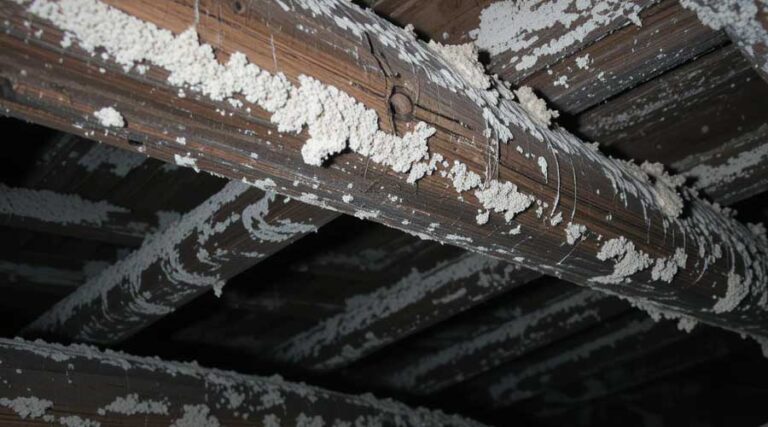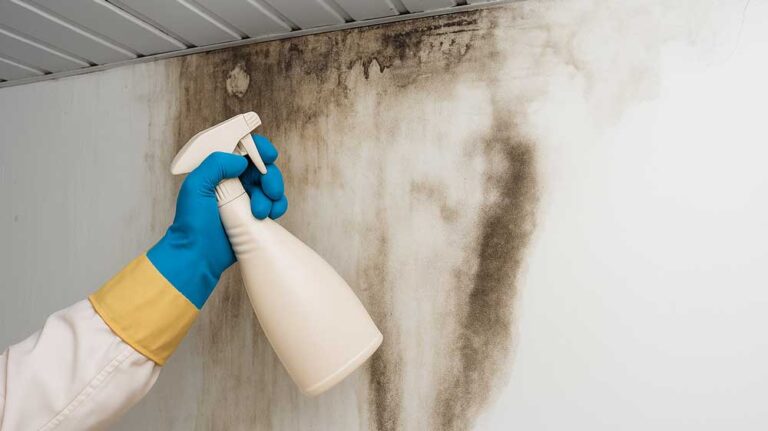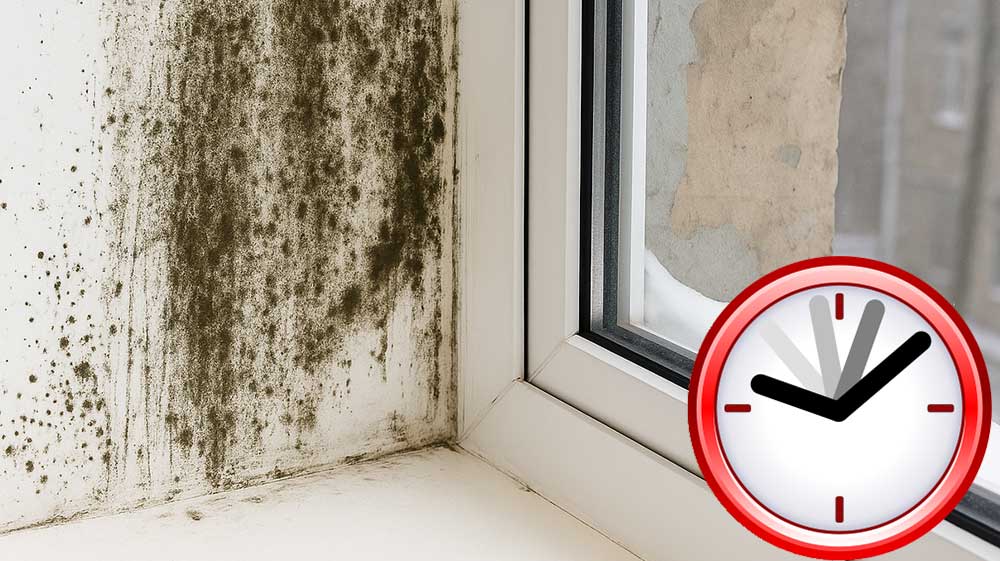
The Hidden Danger Growing in Your Home
You notice a small, dark patch in the corner of your bathroom ceiling. “I’ll deal with it this weekend,” you think. But that tiny spot of mold is already releasing thousands of microscopic spores throughout your home. By the time the weekend arrives, that patch has doubled in size, and invisible colonies may be forming elsewhere.
Here at WaterFixPro, we research and analyze the best solutions for home water and moisture problems. We’ve seen this scenario described by countless homeowners who delay mold remediation only to face more extensive damage, higher costs, and potential health complications. This comprehensive guide explains why immediate action is crucial when dealing with household mold.
What Is Mold Remediation?
Mold remediation is the process of identifying, containing, removing, and preventing mold growth in indoor environments. Unlike simple cleaning, proper mold remediation addresses not just the visible mold but also:
- Identifying and correcting the moisture source
- Establishing containment to prevent spore spread
- Removing contaminated materials that cannot be salvaged
- Cleaning and disinfecting affected areas
- Taking preventative measures to avoid future growth
Professional mold remediation follows industry-standard protocols established by organizations like the Institute of Inspection, Cleaning and Restoration Certification (IICRC) and guidelines from the Environmental Protection Agency (EPA).
Understanding Mold’s Rapid Reproduction Cycle
Mold isn’t just unsightly—it’s a living organism that follows an aggressive growth pattern:
- Mold spores are everywhere in our environment, indoors and outdoors
- They remain dormant until they encounter moisture
- Once activated by water, spores can germinate within 24-48 hours
- A single mold colony can release millions of new spores
- Under ideal conditions (moisture and organic material), mold colonies double every 3-4 days
According to the EPA’s Mold Remediation Guidelines, mold can begin growing on suitable surfaces within 24-48 hours of water exposure and spread rapidly from there.
What makes mold particularly dangerous is its ability to grow undetected behind walls, under flooring, in ceiling cavities, and inside HVAC systems. By the time you notice visible mold, the problem is often much more extensive than it appears.
Health Impacts: More Serious Than You Think

Mold exposure isn’t just about sniffling and sneezing. According to the Centers for Disease Control and Prevention (CDC) Mold and Dampness Guidance, mold can cause a wide range of health problems:
Respiratory Issues
- Coughing and wheezing
- Throat irritation
- Nasal stuffiness
- Worsened asthma symptoms
- Bronchitis
Allergic Reactions
- Skin rashes
- Red, itchy eyes
- Chronic sinusitis
- Headaches
Severe Complications
For people with compromised immune systems, young children, elderly individuals, and those with existing respiratory conditions, mold exposure can lead to:
- Fungal infections in the lungs
- Hypersensitivity pneumonitis
- Chronic inflammatory response syndrome
Important fact: The World Health Organization (WHO) Report on Indoor Dampness links damp, moldy indoor environments to a 20-30% increased risk of childhood asthma development.
When Is Mold Remediation Required?
Knowing exactly when professional intervention becomes necessary is crucial for protecting both health and property. Here are the specific scenarios that demand immediate mold remediation:
Size-Based Guidelines
- Any mold growth larger than 10 square feet (approximately 3′ x 3′) requires professional remediation according to EPA guidelines
- Multiple small patches throughout a room or area, even if each is small
- Any size mold growth in HVAC systems
Health-Based Indicators
- Residents experiencing new or worsened respiratory symptoms
- Visible mold in homes with infants, elderly, or immunocompromised individuals
- Strong musty odors even without visible mold
- Mold growth following a diagnosis of mold-related illness
Water Damage Scenarios
- After flooding or major water intrusions
- Any moisture problem that persisted for more than 48 hours
- Hidden moisture issues discovered during renovations
- Recurring mold growth despite cleaning attempts
Special Circumstances
- Suspected toxic mold varieties (though all mold should be treated seriously)
- Mold in critical structural areas
- Insurance-required professional documentation
Delaying remediation in these situations can lead to expansive growth, increased remediation costs, and potential health complications.
Structural Damage: Your Home’s Silent Deterioration
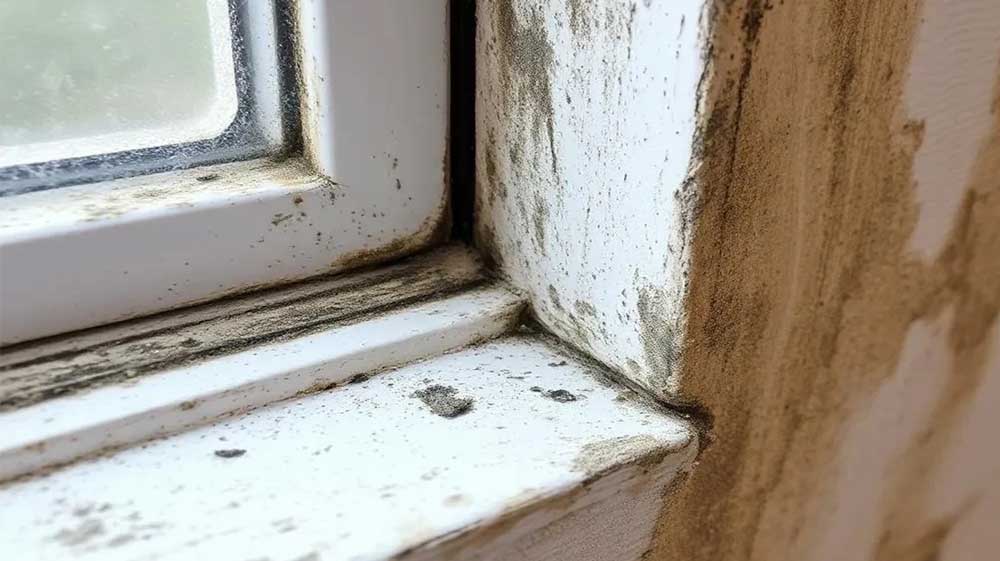
While health concerns are paramount, mold’s impact on your home’s structural integrity shouldn’t be overlooked.
Mold doesn’t just grow on surfaces—it consumes them. Mold digests organic materials like:
- Wood framing and subfloors
- Drywall paper backing
- Ceiling tiles
- Insulation materials
- Carpet padding
Over time, this consumption weakens structural elements, potentially leading to:
- Rotted wood supports and beams
- Compromised drywall integrity
- Damaged insulation (reducing energy efficiency)
- Deteriorated flooring systems
In extreme cases of prolonged exposure, entire sections of walls or ceilings may require complete removal and rebuilding—costs that far exceed early remediation.
The Financial Impact of Delayed Response
Procrastination with mold remediation carries a steep price tag:
Early Intervention vs. Delayed Response:
| Remediation Timeline | Average Cost Range | Additional Considerations |
|---|---|---|
| Within 48 hours | $500-$1,500 | Typically confined to surface cleaning |
| Within 1 week | $1,500-$3,000 | May require some material removal |
| Within 1 month | $3,000-$10,000 | Often requires extensive material replacement |
| 3+ months | $10,000-$30,000+ | May involve structural repairs, HVAC cleaning |
Beyond the direct remediation costs, consider these additional financial impacts:
- Medical bills from mold-related health issues
- Increased energy costs from damaged insulation
- Lost work days due to illness
- Decreased property value (mold disclosure requirements in most states)
- Potential insurance complications (many policies limit or exclude mold coverage)
Who Pays For Mold Remediation?
Understanding financial responsibility for mold remediation is often confusing for homeowners. The answer depends on several factors:
Homeowner’s Insurance
Most standard homeowner’s insurance policies limit or exclude mold damage unless it results directly from a “covered peril” such as:
- Sudden and accidental water damage (burst pipes)
- Fire suppression water damage
- Storm damage that creates immediate water intrusion
Many policies specifically exclude:
- Mold resulting from long-term humidity issues
- Maintenance-related mold problems
- Flooding-related mold (requires separate flood insurance)
- Sewer backup-related mold
Some insurers offer separate mold coverage riders for an additional premium.
Landlord Responsibilities
For rental properties, financial responsibility typically depends on:
- Local housing codes and regulations
- Lease agreement terms
- Cause of the moisture problem
- Documentation of notification to landlord
In most jurisdictions, landlords must maintain habitable living conditions, which includes addressing mold issues resulting from structural problems or building systems failures.
Home Warranty Coverage
Most standard home warranties exclude mold remediation but may cover:
- Repair of the underlying cause (plumbing leak, etc.)
- Replacement of damaged systems within coverage limits
Builder/Contractor Liability
For newer homes or recent renovations:
- Builder’s warranty may cover construction defects leading to water intrusion
- Contractor liability insurance might apply if improper work caused the moisture problem
Special Circumstances
- Condominium associations typically cover mold originating from common areas or building envelope issues
- Previous homeowners may bear responsibility if they failed to disclose known mold problems
- Third-party water damage (neighbor’s leak affecting your unit) may be covered by their liability insurance
We recommend reviewing your specific insurance policy and consulting with your insurance provider about your coverage details.
Identifying Mold In Your Home: Early Warning Signs
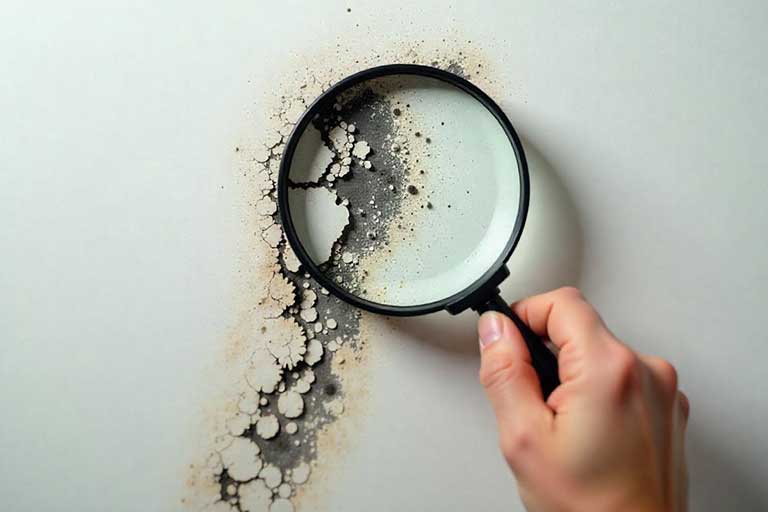
Being proactive about mold detection can save thousands in remediation costs. Watch for these indicators:
Visual Clues
- Discoloration on walls, ceilings, or floors
- Peeling or bubbling paint or wallpaper
- Water stains or yellowing
- Warping of wood surfaces
Physical Sensations
- Musty, earthy odors (especially in enclosed spaces)
- Increased allergy symptoms indoors
- Feeling of dampness in specific areas
- Condensation on windows or walls
Environmental Factors
- Recent water intrusion (flooding, leaks, etc.)
- Humidity levels consistently above 60%
- Poor ventilation in bathrooms or kitchens
- Previous mold issues that weren’t properly remediated
DIY vs. Professional Remediation: When to Call Experts
For very small areas of surface mold (less than 10 square feet), the EPA suggests DIY cleaning may be appropriate:
- Wear protective gear (N95 respirator, gloves, eye protection)
- Scrub hard surfaces with detergent and water
- Dry completely
- Apply an EPA-registered antimicrobial solution
However, professional remediation becomes necessary when:
- The affected area exceeds 10 square feet
- The mold appears black or dark green (potentially toxic varieties)
- Mold is in HVAC systems or inside wall cavities
- You have respiratory conditions or immune system concerns
- There’s a persistent moisture problem requiring expert diagnosis
How Long Does Mold Remediation Take?
The timeline for complete mold remediation varies widely depending on several factors. Here’s what you can expect:
Assessment Phase: 1-2 Days
- Initial visual inspection: 1-2 hours
- Moisture mapping: 2-4 hours
- Air quality testing (if needed): 24-48 hours for results
- Development of remediation plan: 1 day
Containment Setup: 4-8 Hours
- Establishing physical barriers
- Setting up negative air pressure systems
- Sealing HVAC vents in affected areas
- Creating clean rooms and decontamination areas
Active Remediation: 1-7 Days
- Small areas (under 10 sq ft): 1-2 days
- Medium areas (10-100 sq ft): 2-5 days
- Large areas (over 100 sq ft): 5-7 days
- Whole-house contamination: 1-2 weeks
Additional Time Factors
- Structural demolition requirements: Add 1-3 days
- Material replacement: Add 2-7 days
- HVAC system involvement: Add 1-2 days
- Clearance testing: Add 1-3 days
Complete Restoration
- Cosmetic repairs (painting, etc.): 1-3 days
- Replacement of removed materials: 2-7 days
- Final inspection and clearance: 1 day
For standard residential remediation with moderate contamination, the entire process typically takes 3-7 days. More extensive contamination or complications can extend this timeline to 2-4 weeks.
Most remediation specialists can provide a more accurate timeline after completing their initial assessment.
What to Expect During Professional Mold Remediation
Based on our research and expert interviews, here’s what a comprehensive mold remediation process typically includes:
1. Thorough Assessment
- Advanced moisture detection equipment
- Infrared cameras to identify hidden moisture sources
- Air quality testing for mold spore concentration
- Identification of mold species (when necessary)
2. Containment Protocols
- Negative air pressure environments
- HEPA filtration systems
- Physical barriers to prevent cross-contamination
- Protection of unaffected areas
3. Safe Removal & Cleaning
- Industry-approved antimicrobial treatments
- HEPA vacuuming of all surfaces
- Proper disposal of contaminated materials
- Cleaning of contents and belongings
4. Source Correction
- Identifying and fixing the moisture source
- Improving ventilation when needed
- Installing humidity control measures
- Addressing structural issues contributing to moisture
5. Prevention Planning
- Customized recommendations for your specific home
- Humidity monitoring systems
- Regular inspection schedules
- Early warning system implementation
Prevention: Your Best Defense Against Future Mold Problems
The most cost-effective approach to mold is preventing it entirely:
Moisture Control
- Maintain indoor humidity between 30-50% (as recommended by the EPA)
- Use dehumidifiers in naturally damp areas
- Fix leaks promptly (even minor ones)
- Dry wet areas within 24-48 hours
Ventilation Improvements
- Install exhaust fans in bathrooms and kitchens
- Ensure clothes dryers vent outside
- Use ceiling fans to improve air circulation
- Open windows when weather permits (unless outdoor humidity is high)
Regular Maintenance
- Inspect plumbing systems quarterly
- Check roof and foundation annually
- Clean gutters and ensure proper drainage
- Monitor attic and crawlspace conditions seasonally
Smart Remodeling Choices
- Select mold-resistant drywall for bathrooms
- Consider permeability ratings for paints and finishes
- Install proper vapor barriers in new construction
- Choose appropriate insulation for your climate
FAQ: Common Questions About Mold Remediation
Q: Is black mold always toxic? A: Not all dark-colored molds produce mycotoxins. However, proper testing is the only way to determine if a mold is potentially hazardous. The CDC recommends treating all mold with appropriate caution regardless of color.
Q: Will my insurance cover mold remediation? A: Coverage varies widely between policies. Most standard homeowner policies limit or exclude mold damage unless it results directly from a covered peril (like a burst pipe). We recommend reviewing your specific policy details.
Q: How long does professional mold remediation take? A: Timeline depends on the extent of contamination. Small areas may be completed in 1-2 days, while extensive remediation might require 1-2 weeks. Most remediation companies can provide specific timelines after assessment.
Q: Can I stay in my home during mold remediation? A: For limited remediation with proper containment, remaining in unaffected areas is often possible. For extensive contamination or individuals with respiratory sensitivities, temporary relocation may be recommended.
Q: Once removed, will mold come back? A: If the underlying moisture issue is properly addressed, mold should not return. Recurring mold typically indicates persistent moisture problems that weren’t fully resolved.
Q: Who pays for mold remediation in rental properties? A: This depends on lease terms and the cause of the mold. Generally, landlords are responsible for mold resulting from structural issues, while tenants may be liable if their actions created the moisture problem.
Take Action Today: Your Mold Remediation Checklist
Don’t let a small mold problem become a major crisis. Follow these steps:
- Document the problem – Take photos of visible mold and affected areas
- Control humidity – Deploy dehumidifiers immediately
- Schedule an assessment – Professional evaluation reveals the true extent
- Address water sources – Fix leaks or moisture issues promptly
- Begin remediation – Whether DIY or professional, don’t delay
- Implement prevention – Install humidity monitors and improve ventilation
Finding Qualified Mold Remediation Professionals
When selecting a mold remediation service, look for these qualifications:
- Certification from recognized organizations (IICRC, NAMRI, NORMI)
- Positive customer reviews and testimonials
- Clear, detailed written estimates
- Proper insurance coverage
- Guarantee of work performed
- Post-remediation testing procedures
We recommend getting quotes from at least three certified professionals before making your decision.
Conclusion: Act Quickly, Save More
When it comes to mold, time is literally money—and potentially your health. Every day of delay allows colonies to expand, damage to worsen, and remediation costs to climb. The investment in prompt, professional remediation pays dividends through preserved structural integrity, better indoor air quality, and peace of mind.
Don’t wait until your small mold problem becomes a major renovation. Contact qualified mold remediation specialists today for a thorough assessment and tailored remediation plan.
[CTA BUTTON: Find Top-Rated Mold Remediation Specialists In Your Area]
This article was researched and prepared by the water damage and moisture content experts at WaterFixPro. While we strive to provide accurate information, this article is for educational purposes only and should not replace professional assessment of your specific situation.
Related Resources:
Sources:
